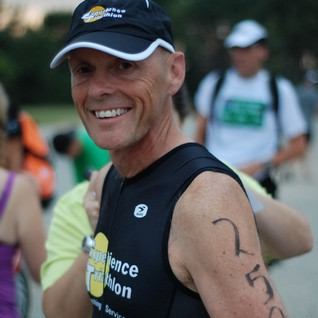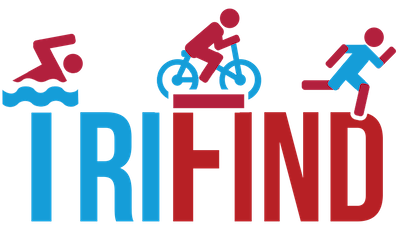Transitions Plan and Practice
 Can there be such a thing as Free Speed in triathlon? Yes, and it can be found in the transition from swim to bike and again in the transition from bike to run. Even if your goal is taking your time and having fun with the race, planning and practicing efficient transitions will make your stress levels lower and the race go better. If your goal is to improve on your past race performance or place higher in your age group, then mastering transitions is a key component and can often take 3 to 5 minutes off your overall race time. You’d have to work pretty hard and for many, many months to take that kind of time off your bike or run split!
Can there be such a thing as Free Speed in triathlon? Yes, and it can be found in the transition from swim to bike and again in the transition from bike to run. Even if your goal is taking your time and having fun with the race, planning and practicing efficient transitions will make your stress levels lower and the race go better. If your goal is to improve on your past race performance or place higher in your age group, then mastering transitions is a key component and can often take 3 to 5 minutes off your overall race time. You’d have to work pretty hard and for many, many months to take that kind of time off your bike or run split!
Planning your transition strategy starts long before the day of the event. In fact, by race day, you should have practiced your transition flow enough times that it is burned into your memory and can be executed without much thought.
The general rule for fast transitions is to keep it simple. Having the right equipment will help with that. Start by purchasing a tri top and tri short. These items are designed to be worn from start to finish so no change of clothes is needed. Next on the list is a pair of speed laces for your running shoes. These inexpensive elastic laces stretch so that your shoes can be put on quickly and without having to tie laces. Last is a race belt. This inexpensive elastic belt allows you to quickly attach your race bib number around your waist as you go out for the run. It eliminates the need to pin your bib to your shirt and have it flapping around on the bike. That’s really all the special equipment needed for smoother transitions.
Now that you have the equipment, it’s time to practice! Yes, you’ve spent hours and hours doing swim, bike and run workouts and you must practice the transitions too! Besides having the wrong equipment or way too many pieces of equipment to deal with in transition, not practicing is the next most common reason why athletes slow down and struggle within the transition area. To practice, set up your own small transition area at home. Lay everything you’ll need on a small hand size towel next to your bike. Then run up to it as if you just got out of the pool. Some athletes will even jump in the shower and be wet so they can simulate the issues associated with wet skin (like how to pull socks onto wet feet). Think very carefully about where everything is placed on the towel or bike and exactly what movements you’re going to make. Consider what will you do first, then second, etc. One trick I like to use is to go through the entire “grab and go” sequence in very slow motion, making mental notes and taking mental video with your eyes on how it all flows. Then as you practice it over and over again, tell your mind to re-run the video sequences you just burned into the brain. Always do the steps in the same order, like grab sunglasses, then helmet, then buckle helmet, then socks (if used), then shoes, then lift bike off rack, then run with bike to transition exit. Keep it simple and easy to repeat!
You’ve practiced your transitions dozens of times and it’s race day. You’re ready for the free speed, right? Not so fast. There are plenty of additional attributes to smooth transitions on race day and they can’t be practiced at home. It all starts with bringing only what you need into transition so your small area around your bike is not cluttered and difficult to maneuver around. Don’t bring big bags, buckets to sit on or to wash the sand off your feet. Just bring what you’ll race with. Next step is to get there early and get a good spot on the transition racks. Sounds simple, but every year I’m standing outside of transition in the morning and the line into transition gets longer and longer the closer it gets to the race start. Sometimes I see athletes arriving after the transition area has closed and the race is ready to start. Not only is this a problem for finding a good spot on the rack, it adds big stress to your race start and day.
Once you’ve secured your great transition spot, you’ll have plenty of time to get the lay of the land. This is super critical. It is chaos in transition during the race. Athletes are running in all directions at high speeds trying to get into or out of their small spots and the transition entry/exit points. Take the time before the race to memorize exactly where your bike is located within transition. Look for landmarks like small trees, curbs, paths, etc. or count the number of bike rows from the place you’ll enter from the swim. Don’t fall for the common suggestion of bringing a colored helium balloon to mark your rack spot. Your balloon will either pop in the car, be a pain to carry to the race or be the same color as dozens of other balloons. Remember, keep it simple and bring only what you need. Once you have your spot memorized, now take time to actually walk the “flow” of the race transitions. Come into the transition area from the swim location, walk toward your bike while counting rows and take those mental pictures again of your bike location. When you get to your bike, chant through the “grab and go” steps you’ve practiced and memorized… sunglasses on, helmet on, helmet buckled, etc. Mentally grab your bike and walk toward the bike “OUT” exit. Again, you’re learning the exact path you plan to take. Make a note of any uphill/downhill portions and sharp turns so you don’t slip and fall. Also find the “mount” line, the point at which you can finally get on your bike. Make sure you look at the pavement for any gravel or slight inclines. These can be very dangerous when you try and get on the bike. Most athletes stop right at the line, in the center of the road, and get on their bikes. It can be a traffic jam and can cause a fall. I like to find a spot about 10 feet past the line and off to the side to get on the bike. Just less chance of someone running into me during the bike mount.
Next it’s time to find the bike “IN” point and think about the dismount. Again, look over the pavement for any danger spots and pick the spot a few feet before the dismount line where you’re going to get off your bike. Most athletes will fly up to the dismount line, slam the brakes and almost fall off their bike. Avoid this mess by thinking ahead and getting off a little early and to the side. Now walk into transition and think about where your towel is located. Keep in mind that during the race your spot will not be marked by your bike since you’ll have it with you. Now you’re looking for a towel and there are lots of white towels on the ground. One tip is to bring a towel that is unique in color or design. Count the rows or find the landmarks that will ensure you find your towel and the spot to re-rack your bike. As you approach your spot, start thinking about the “grab and go” steps again…. Lift bike to rack, unbuckle helmet, take helmet off, grab race belt, grab run hat, etc. and then walk the path toward run “OUT”.
Repeat this entire walk-through of the transition flow as many times as you have time for before you start your warm-up for the race.
Take the time now to plan and practice your transitions and get some Free Speed at your next race!
Joe LoPresto is the Founder and Head Coach of Experience Triathlon Coaching Services. As leaders in the endurance coaching industry, Coach Joe and the Experience Triathlon coaching team help athletes of all ages and abilities achieve success in training, racing and life. Learn more about Coach Joe and Experience Triathlon at www.experiencetriathlon.com and www.ET-Youth.com.


